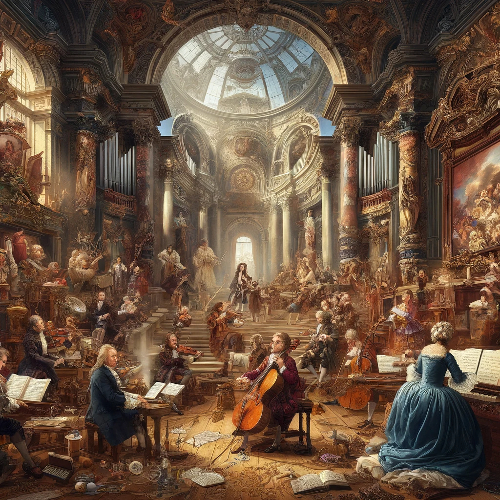The Baroque period, which lasted from the beginning of the seventeenth century to the middle of the eighteenth century, was a rich and complex artistic period. It is characterized by an explosion of creativity in all fields, whether in music, art, architecture or literature. This article explores the many facets of this era, offering an in-depth understanding of its essence and legacy.
Origins and Historical Context
The Baroque period has its roots in the late Renaissance, in a context of great social, political and religious changes. The Protestant Reformation and the Catholic Counter-Reformation played a crucial role in the emergence of this style, seeking to touch the hearts and minds of the faithful through more emotional and dramatic artistic expression.
Characteristics of the Baroque Style
The Baroque style is distinguished by its grandeur, opulence and dynamism. Whether through elaborate sculptures, detailed paintings or intricate musical compositions, the Baroque aims to impress and move. Artists often use trompe l'oeil effects and bold perspectives to create striking illusions.
Baroque Architecture
Baroque architecture is characterized by curved shapes, abundant ornamentation and a play of light and shadow. Notable examples include St. Peter's Basilica in the Vatican and the Palace of Versailles in France. These buildings reflect the power and wealth of their patrons, while serving as places of spiritual and social gathering.
Baroque music
Baroque music is a central element of this era, developing through compositions that combine complexity and emotion. The works of composers such as Johann Sebastian Bach, Antonio Vivaldi, and Jean-Philippe Rameau are emblematic of this style. Baroque music is distinguished by its use of basso continuo, fugue and concerto forms, and rich ornamentation.
Baroque composers
- Johann Sebastian Bach : Considered one of the greatest composers of all time, Bach made invaluable contributions to Baroque music with works like the "Brandenburg Concertos" and the "Cello Suites".
- Antonio Vivaldi : Famous for his "Four Seasons", Vivaldi enriched the baroque repertoire with vibrant and dynamic concertos.
- Jean-Philippe Rameau : French composer and theorist, Rameau influenced Baroque opera with works such as "Hippolyte et Aricie".
Baroque Art
Baroque art is characterized by a strong expressiveness and a dramatic sense of movement. Painters such as Caravaggio and Peter Paul Rubens created works that captivate with their emotional intensity and masterful use of light and shadow. Baroque in visual art seeks to capture the moment and convey powerful emotions.
The Baroque in Literature
In literature, the Baroque period saw the emergence of various genres, from theatre to epic poetry. The works of this period often reflect the tensions and contradictions of their time, exploring themes of power, faith, and the human condition with great psychological depth.
The Influence of Baroque Music on Classical Music
The transition from Baroque to classical music in the mid-eighteenth century brought significant changes in musical composition and performance. Forms and techniques developed during the Baroque period, such as counterpoint and basso continuo, profoundly influenced later classical composers such as Mozart and Haydn.
The Baroque Legacy
The influence of the Baroque era was felt far beyond its own century. In architecture, music, and the visual arts, the Baroque has left a lasting imprint that continues to inspire contemporary artists and creators. The techniques and styles developed during this period are still studied and admired today.
Evolution of the Baroque Movement
The Baroque movement has evolved over the decades, adapting to cultural and regional contexts. In Italy, the Baroque was particularly marked by grandiose religious works, while in France it often manifested itself in royal architecture and French gardens. Each region has brought its own interpretation of the Baroque style, enriching its diversity.
Baroque and Modernity
The term "baroque" is often used nowadays to describe works and artistic styles that escape simplicity and austerity. The richness and complexity of the Baroque continue to inspire creations in various fields, from fashion to contemporary music, demonstrating the lasting impact of this artistic period.
FAQs
What is the Baroque period?
The Baroque period is an artistic period that extends from the beginning of the seventeenth century to the middle of the eighteenth century, characterized by great expressiveness, ornamental richness and strong emotion.
Who are the main composers of baroque music?
Leading composers of Baroque music include Johann Sebastian Bach, Antonio Vivaldi, and Jean-Philippe Rameau, known for their complex and emotional works.
How does the Baroque style manifest itself in architecture?
The Baroque style in architecture is characterized by curved forms, abundant ornamentation, and a dramatic play of light and shadow, as seen in St. Peter's Basilica and the Palace of Versailles.
What is the difference between baroque music and classical music?
Baroque music is distinguished by the use of the basso continuo and complex forms such as the fugue, while classical music, which follows the Baroque period, emphasizes clarity, balance and formal structure.
What is the impact of Baroque art on modern culture?
Baroque art continues to influence modern culture with its ornamental richness and dramatic expressiveness, inspiring creations in various contemporary artistic fields.
Why is the Baroque period important?
The Baroque period is important because it represents a period of great artistic and cultural innovation, having left a lasting legacy in art, music, and architecture.
Conclusion
The Baroque period is a fascinating period in artistic history, marked by unparalleled richness and diversity. By exploring its many aspects, from music to architecture, we can appreciate the breadth of its influence and the depth of its legacy. This period continues to enrich our culture and inspire today's creators, a testament to its eternal importance.


